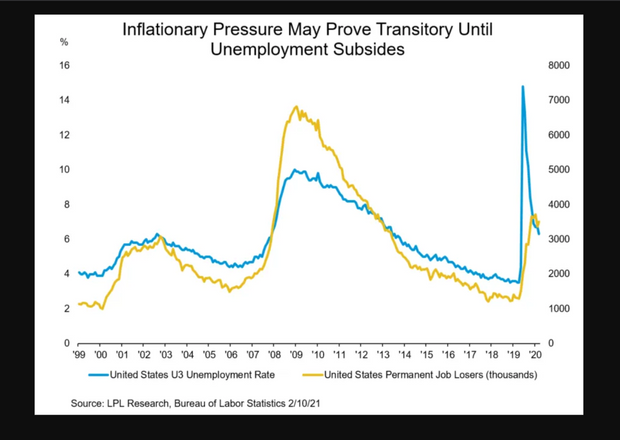When America’s amusement parks and baseball stadiums no longer must serve as mass COVID-19 vaccination sites, some investors believe that households pocketing pandemic aid might start to splurge.
While that initially could boost the hardest hit parts of the economy devastated by the pandemic, a bigger concern for investors is that a sustained spending spree also could cause prices for goods and services to rise dramatically, hurt the economy and dent financial asset values.
“I don’t think inflation is dead,” said Matt Stucky, equity portfolio manager at Northwestern Mutual Wealth Management Company. “The desire by key policy makers is to have it, and it’s the strongest it’s ever been. You will see rising inflation.”
Wall Street investors and analysts have become fixated in recent weeks on the potential for the Biden Administration’s planned $1.9 trillion fiscal aid package that targets relief to hard-hit households to cause inflation to spiral out of control.
Economists at Oxford Economics said on Friday they expect to see the “longest inflation stretch above 2% since before the financial crisis, but it’s unlikely to sustainably breach 3%.”
Severe inflation can hurt businesses by ratcheting up costs, pinching profits and cause stock prices to fall. The value of savings and bonds also can be chipped away by sharp inflation over time.
Another worry among investors is that runaway inflation, which took hold in the 1980s and pushed 30-year mortgage rates near 18%, could force the Federal Reserve to taper its $120 billion per month bond purchase program or to raise benchmark rates above its current 0% to 0.25% target sooner than expected and spook markets.
At the same time, it’s not far-fetched to argue that some financial assets already have been inflated by the Fed’s pedal-to-the-metal policy of low rates and easy flow of credit, and might be due for some cooling off.
U.S. stocks, including the Dow Jones Industrial Average DJIA, +0.09%, S&P 500 index SPX, +0.47% and Nasdaq Composite COMP, +0.50% closed on Friday at all-time highs, while debt-laden companies can now borrow in the corporate “junk” bond, or speculative-grade, market at record low rates of about 4%.
Read: Stock market stoked by stimulus hopes — what investors are counting on
In addition to rallying stocks and bonds, home prices in the U.S. also have gone through the roof during the pandemic, despite the U.S. still needing to recoup almost as many jobs from the COVID-19 crisis as during the worst of the global financial crisis.
This chart shows that jobs lost to the pandemic remain near to levels seen in the aftermath of the last crisis.

Job losses need to be tamed
LPL Research, Bureau of Labor Statistics
Fed Chairman Jerome Powell said Wednesday that he doesn’t expect a “large or sustained” outbreak of inflation, while also stressing that the central bank remains focused on recouping lost jobs during the pandemic, as the U.S. looks to makes serious headway in its vaccination program by late July.
Treasury Secretary Janet Yellen on Friday reiterated a call on Friday that the time for more, big fiscal stimulus is now.
“Broadly, the guide is, does it cost me more to live a year from now than a year prior,” Jeff Klingelhofer, co-head of investments at Thornburg Investment Management, said about inflation in an interview with MarketWatch.
“I think what we need to watch is wage inflation,” he said, adding that higher wages for upper earners were mostly flat for much of the past decade. Also, many lower-wage households hardest hit by the pandemic have been left out of the past decade’s climb in financial asset prices and home values, he said.
“For the folks who haven’t taken that ride, it feels like a perpetuation of inequality that’s played out for some time,” he said, adding that the “only way to get broad inflation is with a broad overheating of the economy. We have the exact opposite. The bottom third are no where near overheating.”
Klingelhofer said it’s probably also a mistake to watch benchmark 10-year Treasury rates for signs that the economy is overheating, which would stoke inflation, since, “it’s not a proxy for inflation. It’s just a proxy for how the Fed might react,” he said.
The 10-year Treasury yield TMUBMUSD10Y, 1.209% has climbed 28.6 basis points on the year to date to 1.199% as of Friday.
But with last year’s double-digit price increases, has the U.S. housing market become at risk of overheating?
“Not at current interest rates,” said John Beacham, the founder and CEO at Toorak Capital, which finances apartment buildings and single family rental properties, including those going through rehabilitation and construction projects.
“Over the course of the year, more people will go back to work,” Beacham said, but added that it’s important for policy makers in Washington to provide a bridge for households through the pandemic, until spending on socializing, sporting events, concerts and more can again resemble a time before the pandemic.
“Clearly, there likely will be short-term consumption increase,” he said. “But after that it normalizes.”
The U.S. stock and bond markets will be mostly closed on Monday for Presidents Day, which technically isn’t the name of the holiday.
On Tuesday, the only tidbit of economic data comes from the Empire State manufacturing index, followed Wednesday by a slew of updates on retail sales, industrial production, home builders data and minutes from the Fed’s most recent rate-setting meeting. Thursday and Friday bring more jobs, housing and business activity data, including existing home sales for January.










Add Comment